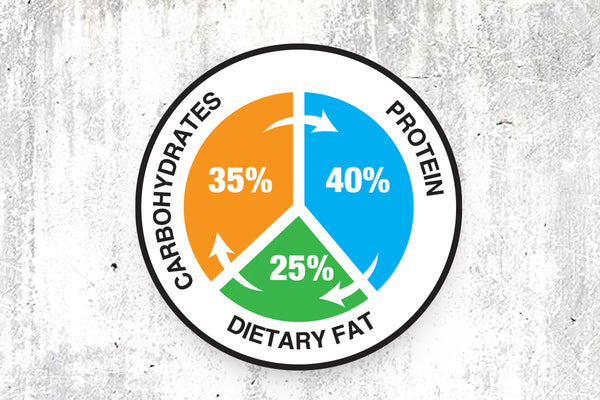The Zone Diet has remained one of the most reasonable, effective, and sustainable diets since its debut over 40 years ago, continuing to gain popularity among the masses. The 1UP Fitness App incorporates this tried-and-true method into its customized nutritional plans, offering a 'macro breakdown' that adheres to the principles of the Zone Diet
Today, we’re discussing all things Zone -- what it is, what you can (and cannot) eat, and is it effective for losing weight?
Let’s get started.
What is the Zone Diet?
Created by Dr. Barry Sears in the 1970s, the Zone Diet is a whole food-focused diet created to reduce “dietary inflammation.”
According to the creators of the Zone Diet, diet-induced inflammation is a physiological state characterized by[2]:
- “Excess dietary caloric intake causing oxidative stress.
- Excess dietary intake of omega-6 fatty acids that promote inflammation.
- Excess dietary intake of the saturated fatty acids, especially palmitic acid, that promotes inflammation.
- Lack of dietary intake of omega-3 fatty acids that reduce inflammation.
- Lack of dietary intake of polyphenols to activate anti-oxidative genes to reduce oxidative stress.
- Lack of dietary intake of polyphenols to promote gut health.
- Lack of dietary intake of fermentable fiber to promote gut health.”
With inflammation decreased, Dr. Sears and fellow Zone proponents believe an individual’s risk of disease is reduced considerably and their rate of fat loss will increase significantly.
The reason for this is that chronic systemic inflammation is associated with a number of chronic diseases including[3]:
- Diabetes
- Metabolic syndrome
- Obesity
- Chronic obstructive pulmonary disorder (COPD)
- Cardiovascular disease
- Arthritis
While it was developed in the 1960s, it wasn’t until the 1990s that the diet really took off, thanks to the release of Dr. Sears’ book, Enter the Zone.
Zone Diet Four Pillars to “Maintain Wellness”
Like all diets, the Zone Diet has a set of guidelines, or in this case “pillars”, to which it ascribes.
Those four pillars are:
- Restrict calories without fatigue or hunger
- Control microbiome-induced inflammation
- Maintain an “appropriate balance” of inflammation in the body
- Consume sufficient dietary polyphenols to “activate genes” for improved wellness
Zone Diet Macronutrients
The Zone Diet prescribes the following macronutrient ratios to its followers:
- 40% Protein
- 35% Carbohydrates
- 25% Fat
According to the creators of the Zone Diet:
“The balance of protein, carbohydrate, and fat at each meal allows you to balance your hormones to reduce your caloric intake without hunger or fatigue for the next four to five hours after a Zone meal.”[2]
As stated above, the diet places an emphasis on consuming minimally processed whole foods.
Carbohydrates should be high in fiber and have a low glycemic index, which offers the benefit of supporting stable blood sugar and energy levels during the day. The high fiber content of the carbohydrate sources should also help Zone Diet followers experience fewer hunger pains during the day too.
Along those lines, the Zone Diet also places a premium on protein.
As you likely know, protein is needed to build and repair muscle tissue. In addition to that, it’s also highly satiating (meaning it keeps you feeling fuller for longer) and has a high thermic effect of food (meaning your body has to expend a greater amount of energy to breakdown, absorb, and utilize than carbs or fats).
The last component of the diet is dietary fat, which Dr. Sears recommends should consist mostly of monounsaturated fats, such as those found in olive oil.
What Foods Can I Eat on the Zone Diet?
One of the great things about the Zone Diet is that it does not place any arbitrary restrictions or eliminate entire food groups from the diet, something in stark contrast to other prominent fad diets like a carnivore, keto, or grapefruit diets.
The Zone diet can be tailored to your dietary and ethical preferences, meaning if you’re vegan, vegetarian, pescatarian, or omnivore, you can follow the diet.
Here is some example of food choices for each of the three macronutrient categories allowed on the diet:
Protein
- Lean beef
- Chicken
- Pork
- Venison
- Fish
- Shellfish
- Egg whites
- Low-fat dairy (milk, cheese, yogurt, etc)
Fat
- Avocados
- Nuts (almonds, pistachios, macadamias, cashews, hazelnuts, etc)
- Nut butter (almond butter, cashew butter, peanut butter, etc.)
- Seeds (sesame, pumpkin, sunflower, etc.)
- Oils (olive oil, canola oil, sesame oil, peanut oil, etc.)
Carbs
- Fruit (strawberries, blueberries, raspberries, apples, oranges, pears, etc.)
- Vegetables of all kinds (dark leafy greens, peppers, mushrooms, summer squash, zucchini)
- Legumes (pinto beans, black beans, red beans, chickpeas, etc.)
- Whole grains (oatmeal, barley, farro, quinoa, etc.)
What Foods Are Not Allowed on the Zone Diet?
Like most diets, the Zone Diet has a list of foods that it prohibits individuals from consuming while following the diet.
Included in the list are:
- Starchy vegetables: Potatoes, peas, corn, carrots, etc.
- High-sugar fruits: bananas, grapes, mangoes, raisins, etc. and potatoes.
- Refined and/or processed carbohydrates: White bread, pasta, bagels, pastries, breakfast cereals, muffins, etc.
- Foods with added sugar: cakes, cookies, candy, and other baked goods
- Sugar-containing drinks: sodas, juices, smoothies, etc..
- Sweetened coffee and tea: unsweetened coffee and tea can be consumed in moderation
Incorporating the Zone Diet into Daily Life
When it comes to incorporating the diet into your everyday life, you have two options from which to choose:
- Hand-eye method
- Zone Food Block Method
Hand-Eye Method
The hand-eye method is just what it sounds like -- you use your hand and eye to estimate appropriate portion sizes to eat at mealtime.
Your hand serves a number of important roles aside from helping to determine portion sizes, too. Your five fingers serve as a reminder that you are supposed to eat five times a day (three meals and two snacks), and that you should never go more than five hours without food.
Note: Zone proponents believe that this regular feeding schedule helps sidestep any grazing or mindless snacking during the day as well as avoid any dips in energy levels due to going too long without eating.
To assemble a Zone-friendly meal, you begin by imaginarily dividing your plate into thirds.
-
The first third of your plate is reserved for a source of lean protein that is roughly the size and thickness of your palm.
-
The remaining two-thirds are filled with low glycemic carbohydrates, preferably one starchy and one non-starchy vegetable, each
- Finally, you are also recommended to consume a small serving of dietary fat, such as a serving of almonds, avocado, or a drizzle of olive oil on your food.
The beauty of the hand-eye method is that it is simple to follow, even for beginners, and it allows for flexibility whether dining at home or at a restaurant.
Zone Food Block Method
Zone’s Food Blocks are based on each individual’s weight, height, waist and hip measurements. From these numbers, you’re able to calculate how many grams of carbs, fat, and protein you’re allotted each day.
Typically, men eat 14 Zone blocks per day, while the typical woman eats 11 Zone blocks per day.
On average, a meal consumes 3-5 Zone blocks, while snacks occupy one zone block.
Each Zone block consists of a carb block, a protein block, and a fat block.
Here’s a little more on what each macronutrient block contains:
- Carbohydrate block: Contains 9 grams of carbs.
- Protein block: Contains 7 grams of protein.
- Fat block: Contains 1.5 grams of fat.
Additional Guidelines
- Your first snack or meal should be consumed no later than 1 hour after waking
- A full meal should be eaten every 4-6 hours
- Individuals should consume an 8-ounce glass of water with every meal
- Meals and snacks should begin with a source of lean protein. Low GI carbs (fruits and veggies) can be added as well as a small number of fats.
- High portions of protein in each meal
Zone Diet Benefits
The Zone Diet is one of the less extreme or controversial fad diets to surface over the years. It places an emphasis on eating whole food meals and snacks evenly spaced throughout the day to support stable energy and blood sugar levels. It also doesn’t overly restrict any food group a la keto, paleo, or veganism.
It does suggest that you limit your intake of processed foods and added sugar, which is a good recommendation regardless of what diet you follow.
Furthermore, unlike other fad diets, the Zone Diet doesn’t lead you to believe that calories do not matter, as evidenced by their promotion of the Zone Food Block system which is based on an individual’s daily macronutrient requirements.
Zone Diet Drawbacks
While the Zone Diet does have several upsides, it is not without its faults.
For starters, the diet makes several health claims (reduced inflammation, faster fat loss, better performance, etc.), yet there is scant evidence to support these claims.
For instance, a study involving athletes following the Zone Diet noted that even though they lost weight, the athletes also experienced a decline in endurance and an increase in exhaustion.[4]
Additionally, the Zone Diet suggests avoiding starchy carbohydrates like bananas and potatoes, both of which are whole foods that are rich in essential nutrients and can be a part of any healthy diet.
Another potential drawback may be the requirement to eat five times per day. This can become tedious for individuals leading an active or busy lifestyle. And, while frequent meals or snacks may help some people to experience less hunger, there’s a significant portion of people who actually felt hungrier when having to eat multiple smaller meals as opposed to two to three larger feedings each day.
Finally, some research indicates that the Zone Diet may be no more effective than other reduced-calorie diets in improving markers of metabolic health, such as triglycerides or blood sugar.[5]
Is the Zone Diet Effective for Losing Weight?
The Zone Diet will be as effective as any other diet.
What we mean by that, is that it will help you lose weight so long as you are able to stick to its rules and guidelines.
When assessing how “effective” a diet is effective for losing weight (and maintaining that weight loss), it always boils down to how sustainable that way of eating is for you over the long term.
If you enjoy the foods you eat on the Zone Diet, then it can be an effective strategy for losing fat and maintaining your body weight.
However, if you feel deprived or stressed by the diet’s strict eating schedule, then your chances of sticking to it are not high, which means you’re not likely to maintain your results.
Any diet that prohibits or “suggests” you minimize your intake whole foods like bananas, potatoes, and other healthy foods, is placing you in a compromised position long term for your relationship with food as well as putting a serious dent in your ability to sustain your weight loss down the road.
Furthermore, there is also a paltry amount of evidence that the Zone Diet's 40% carb, 40% protein and 20% fat ratio is the “optimal” ratio for losing fat or reducing inflammation.
At the end of the day, you need to choose a diet that best matches your lifestyle.
If the constructs of the Zone Diet work for you great, but if not, don’t sweat it. There are a ton of ways to eat healthily, perform better, and lose weight. Find one that works for you and use it until it doesn’t fit your lifestyle anymore.
References
- "The U.S. Weight Loss & Diet Control Market." MarketResearch.com: Market Research Reports and Industry Analysis, 3 May 2017
- "The Zone Diet." Dr. Sears' Zone Labs, www.zonediet.com/the-zone-diet/.
- Pahwa R, Jialal I. Chronic Inflammation. [Updated 2019 Jun 4]. In: StatPearls [Internet]. Treasure Island (FL): StatPearls Publishing; 2019
- Jarvis, M., McNaughton, L., Seddon, A., & Thompson, D. (2002). The acute 1-week effects of the Zone diet on body composition, blood lipid levels, and performance in recreational endurance athletes. Journal of Strength and Conditioning Research, 16(1), 50–57.
- Paddon-Jones, D., Westman, E., Mattes, R. D., Wolfe, R. R., Astrup, A., & Westerterp-Plantenga, M. (2008). Protein, weight management, and satiety. The American Journal of Clinical Nutrition, 87(5), 1558S-1561S. https://doi.org/10.1093/ajcn/87.5.1558S






